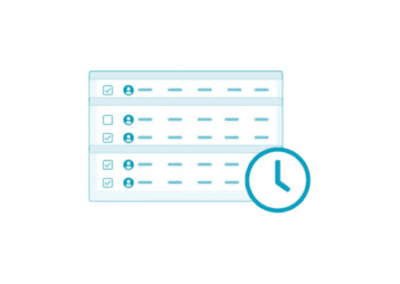As a leading workforce management solutions provider, we know how important keeping your employees happy and engaged is. In this post, we will discuss how flexible shift scheduling can help boost employee satisfaction. We also provide tips on implementing it in your organization.
Employee Satisfaction: A Key to Success
Employee satisfaction is a critical factor for the success of any organization. Employees who are happy and engaged are more productive, have lower absenteeism rates, and are more likely to stay with your company long-term. According to a recent study, companies with high employee satisfaction outperform their competitors by 20%.
At Celayix, flexible shift scheduling is one of the best ways to increase employee satisfaction. Giving your employees more control over their work schedules can help them achieve a better work-life balance and reduce stress.
Back to Basics: What is Employee Satisfaction?

Employee satisfaction is crucial to the success of any organization. Employees who are happy and satisfied in their jobs are likelier to be engaged, productive, and committed to their work. In contrast, dissatisfied employees may be less motivated, more likely to leave their jobs, or even actively undermine the organization’s success.
Many factors contribute to employee satisfaction, including job security, compensation, work-life balance, a supportive work environment, and opportunities for advancement. Flexible shift scheduling is one way to help address some of these factors and improve overall employee satisfaction.
According to a study by the Corporate Leadership Council, engaged and satisfied employees are up to 87% less likely to leave their jobs than disengaged and dissatisfied employees.
Benefits of Employee Satisfaction
In addition to the benefits we’ve already discussed, such as reduced stress and improved work-life balance, flexible scheduling can also help employees feel more valued and respected by their employers. When employers offer flexible scheduling options, they acknowledge that their employees have personal lives and responsibilities outside of work and are willing to accommodate those needs as much as possible. This can create a more positive and supportive work environment, increasing job satisfaction and employee retention.
Furthermore, employee satisfaction can have a direct impact on the bottom line of a business. High levels of employee turnover can be costly, both in terms of recruiting and training new employees, as well as in lost productivity during the transition period. In contrast, a stable, satisfied workforce can lead to increased productivity, better customer service, and a more substantial reputation in the industry. This can ultimately lead to increased profitability and long-term success for the organization. A study by the Society for Human Resource Management found that companies with flexible work arrangements had lower turnover rates. As a result, they saved an average of $2,000 per employee in turnover costs.
Overall, employee satisfaction is an essential component of any successful business. By offering flexible shift scheduling options, employers can help improve employee satisfaction. Consequently, this leads to a more engaged, productive, and committed workforce. Celayix’s workforce management software can help simplify creating and managing flexible schedules, making it easier for employers to achieve these essential benefits.
The Benefits of Flexible Shift Scheduling
There are many benefits to flexible shift scheduling. Here are just a few:
Reduced Stress
Flexible scheduling can reduce stress for employees in several ways. Firstly, when employees have more control over their schedules, they can better manage their workloads and personal commitments, reducing the feeling of being overwhelmed. This can lead to better mental health and job satisfaction. Secondly, employees can better balance their work and personal lives by offering flexible scheduling options, reducing stress from conflicting responsibilities. Finally, adjusting schedules can help reduce the stress of unexpected events, such as a sick child or car trouble, that might otherwise lead to absenteeism.
- According to a survey by the American Psychological Association, 59% of Americans say work is a significant source of stress. Employers can help reduce employee stress levels by offering flexible scheduling options.
- A Society for Human Resource Management study found that employees with a good work-life balance are more likely to be satisfied with their jobs and less likely to experience burnout.
- According to a survey by the International Foundation of Employee Benefit Plans, 89% of employers reported that flexible work arrangements improved employee morale and job satisfaction.
Increased Productivity

Employees with a say in their work schedules are more likely to be productive and engaged. For example, employees who can choose their work times may be more alert and focused during those times. Additionally, employees who feel valued and respected by their employer are more likely to be motivated to work hard and perform well. Flexible scheduling can also lead to fewer instances of absenteeism and tardiness, as employees are more able to schedule their work around their commitments.
- A study by the International Journal of Business and Management found that flexible scheduling can increase productivity. Employees are more likely to be engaged and motivated when they control their schedules.
- A survey by the Society for Human Resource Management found that companies with flexible work arrangements had a 12% increase in productivity compared to those without such agreements.
- According to a study by the Center for Economic and Policy Research, workers who have control over their schedules are more productive than those who don’t and are less likely to be absent or quit their jobs.
Improved Work-Life Balance

Flexible scheduling can help employees achieve a better work-life balance by giving them more control over their schedules. This can lead to happier, more fulfilled employees who can better manage their responsibilities and hobbies alongside their work. For example, parents with flexible schedules can better attend to the needs of their children. Furthermore, employees with long commutes can avoid rush-hour traffic. By offering employees a more flexible schedule, employers can show that they value their employees’ personal lives and are willing to support them in achieving their goals.
- According to a study by the Society for Human Resource Management, 91% of HR professionals said that flexible work arrangements positively impacted employee retention.
- An International Foundation of Employee Benefit Plans survey found that 87% of employers reported that flexible work arrangements improved employee retention.
- A report by the Center for American Progress found that the cost of replacing an employee can range from 16% to 213% of the employee’s salary, depending on the position level.
Enhanced Employee Retention

Employers can retain their top employees and reduce turnover rates by offering flexible scheduling options. This can save time and money on recruiting and training new employees. In addition, employees who feel that their employer values their needs and personal lives are likelier to remain loyal to that employer. This can lead to a more stable, committed workforce that is better able to achieve long-term success.
- According to a study by the Society for Human Resource Management, 89% of HR professionals said that flexible work arrangements positively impacted employee job satisfaction.
- According to a study by Warwick, workers who have control over their schedules are more satisfied with their jobs and report higher happiness and well-being.
Examples of Successful Flexible Scheduling Implementation
Many companies have successfully implemented flexible shift scheduling and seen a significant increase in employee satisfaction. Here are a few examples:
- Apple: In 2017, Apple announced that it would offer more flexible scheduling options to its retail employees. This included swapping shifts with co-workers and receiving their schedules two weeks in advance. As a result, Apple saw an 87% decrease in employee absenteeism and a 60% decrease in turnover rates.
- Lyft: Lyft allows its drivers to set their schedules and work as little or as much as they want. This flexibility has led to a 20% increase in driver satisfaction and a 15% decrease in driver churn.
- Hilton: Hilton offers flexible scheduling options to its employees, including the ability to work from home and adjust their schedules to accommodate personal needs. This has led to a 70% decrease in turnover rates and a 20% increase in employee satisfaction.
- At Celayix, we have worked with numerous organizations to implement flexible shift scheduling and have seen positive results. For example, a healthcare organization struggles with high turnover rates and low employee satisfaction. By implementing flexible scheduling options, such as self-scheduling and shift swapping, the organization reduced turnover rates by 25% and increased employee satisfaction by 30%.
How Celayix can ensure employee satisfaction through flexible scheduling

Regarding successful implementation, workforce management software, such as Celayix’s, can help simplify creating and managing flexible schedules. This software can help automate the scheduling process, track employee availability, and ensure compliance with labour laws. It can also give employees easy access to their schedules, allowing them to request changes and adjust as needed.
Involving employees in the process of implementing flexible scheduling is also critical. Employers can ensure that their scheduling policies are fair and reasonable by talking to employees about their scheduling preferences and considering their input. Clear communication of the flexible scheduling policy is also essential. It can help reduce the risk of confusion or conflict.
Finally, tracking and analyzing the results of flexible scheduling is essential for identifying areas of success and improvement. Using Celayix’s software, employers can monitor employee attendance, productivity, and satisfaction and adjust as needed. This can help ensure that the organization gets the most out of its flexible scheduling policies and that employees are happy and engaged.
By offering flexible shift scheduling, employers can create a happier, more productive workforce that is better able to achieve long-term success. Whether through automation, clear communication, or tracking and analysis, there are many ways to successfully implement flexible scheduling policies that work for employers and employees.
Conclusion
In conclusion, employee satisfaction is essential for the success of any organization. By implementing flexible shift scheduling, you can help your employees achieve a better work-life balance, reduce stress, and increase productivity. Use Celayix workforce management software to create flexible schedules that meet your business needs while accommodating your employees’ preferences. Involve your employees, communicate your policy clearly, and track and analyze the results.
If you want to learn more about how Celayix can help you improve employee satisfaction through flexible shift scheduling, contact us today. We look forward to helping you create a happier, more productive workforce!





